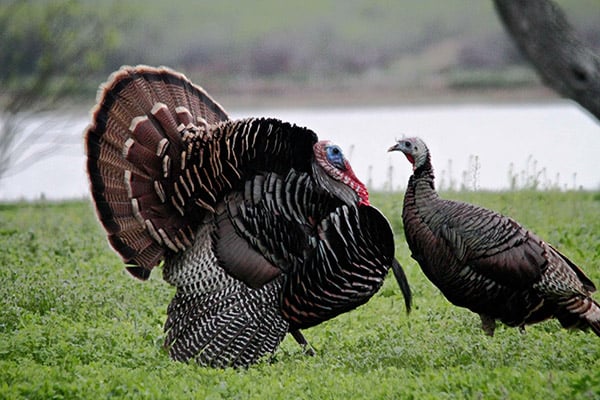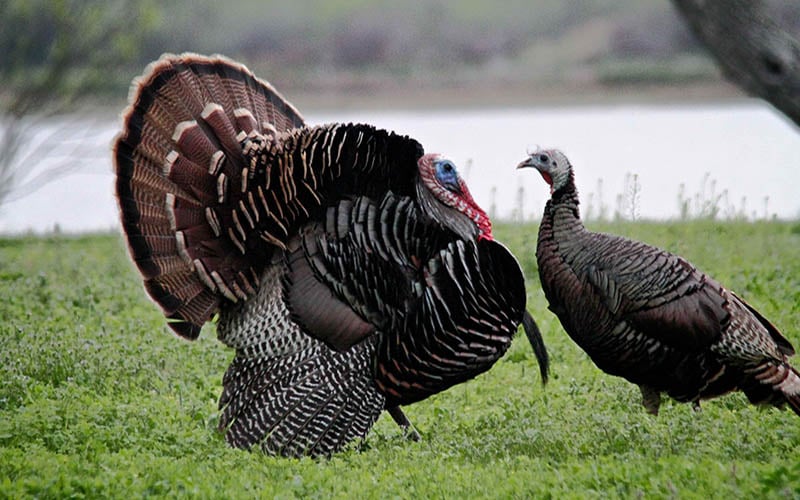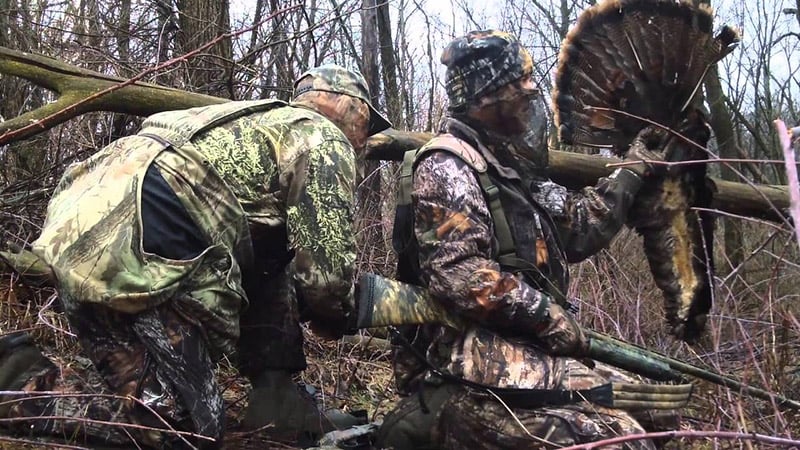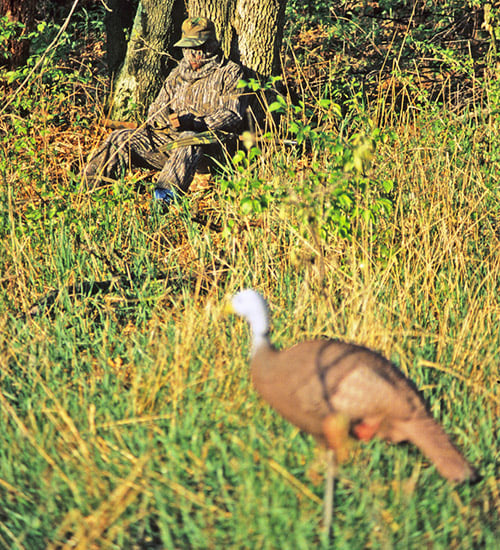
Last Updated on
Eastern Turkeys have been evading and frustrating hunters for centuries in North America. These prized game birds make the challenge worth it!
The Eastern Turkey has been an essential resource in North America for hundreds of years. The Indians relied on these birds for food, arrows, knife-type utensils and head dressings. The early Europeans counted on them for food as well. In fact, Benjamin Franklin believed that the Eastern Turkey, not the Bald Eagle, would be the best symbol for the United States.
Although there are five subspecies of wild turkeys found in the United States, the Eastern Turkey has the biggest population and widest distribution across the country. They occupy rural areas from North Dakota south to Texas and east to the coast, except for the Florida peninsula.
Eastern Turkey History and Current Status
During the time when the first European settlers landed in North America, Eastern Turkeys were abundant. After that point, their population steadily declined until few turkeys remained in the 1960s. The population collapse can be attributed mostly to unregulated market hunting and destruction of habitat.
Today, the Eastern Turkey is once again common throughout most of its original range thanks to habitat restoration projects, hunting regulations, and relocation efforts managed by many different states. In North Carolina alone, the population of Eastern Turkeys went from around 2,000 in 1970 to well over 150,000 in 2010.
Physical Attributes of the Eastern Wild Turkey
Eastern Turkeys, as well as the other subspecies in the United States, have between 5,000 and 6,000 feathers covering their bodies. These feathers provide lift during short flights, serve as essential insulation throughout the winter, add ornamentation for mating rituals and allow for touch sensations,
A wild turkey will undergo five different molts during their lifetime: natal, juvenile, first primary, first winter and primary. Toms (male turkeys) exhibit the most vibrantly-colored plumage with an array of dark hues ranging from striking bronze, red and gold to iridescent copper and green. Hens feature many of the same colors, but their plumage is much more dull and muted making them appear brown from a distance.
Toms also have a “beard” consisting of a group of long follicles centered on their chest. These beards can grow up to 10 inches long and, unlike all the other feathers, they do not go through a molt. The beard follicles appear when toms are about 6 months old and grow throughout their lifetime.
Although hens also have spurs, they are very small and blunt compared to the toms long and sharp spurs. These spurs grow on the inside of the lower third of the leg, and a tom’s spurs can grow to be 2 inches long over time.
Eastern Turkeys can often be differentiated from the other subspecies by their tail feathers. For example, Eastern Turkeys have dark brown tips on these feathers while Rio Grande Turkeys have buff or tan tips.
Eastern Turkey Diet and Habitat
Eastern Turkeys require good habitat diversity consisting of open grasslands interspersed with forested areas. Well-managed forested areas offer essential soft mast and cover for the turkeys throughout most of the year. However, since these birds rely on vision as their primary defense, forests that are too dense will not work for them. They need decent visibility around 50-60 yards and good undergrowth to thrive.
The open grasslands and meadows provide most of the food for Eastern Turkeys. Considered to be opportunistic foragers, Eastern Turkeys have a varied diet consisting mostly of green foliage, grass seeds, nuts, acorns and insects. Proportionately, they eat about 36 percent grasses, 29 percent insects, 19 percent nuts/acorns, and 16% forbs.
The individual plant species consumed by turkeys depends greatly on the region and time of year. For most Eastern Turkeys, water is not a limiting factor to their range. They can survive off of small standing sources of ponding water and through water consumed when eating vegetation.
Hunting Eastern Turkey 101
If you’re looking for a challenging hunting adventure, the Eastern Turkey is a great choice. They are very wary of humans and use their amazing senses of sight and hearing to evade many hunters before there are ever seen. The adult gobblers (or Toms) typically have the most highly-developed survival instincts, which makes them one of the most prized trophies in the United States today.
Turkey hunting differs greatly in style and primary quarry depending on the season. Spring hunting is more common since it has little to no impact on population. There are many non-breeding males that can be taken at no cost to future growth each spring.
The primary spring hunting method involves calling the toms from their roost at daybreak. Hunters use a series of different yelps, cackles, whines and clucks to imitate a hen that is ready to mate. To successfully trick the keen-eyed gobblers, hunters must wear camouflage clothing and sit motionless for hours.
Fall turkey hunting is typically only available in areas with well-established populations. Hunting the birds during the fall must be well regulated to avoid significant population decline. Most fall turkey hunters look for flocks of turkeys and call them closer by imitating adult hens or lost young birds. Since toms are usually not interested in hens during the fall, they are extremely difficult to hunt during this time.
Hunting Eastern Turkey – Important Gear and Equipment
Although all forms of game hunting require some gear, turkey hunters truly know the importance of having the right tools with them when they need them. It is much better to have some gear you don’t need on a given trip than need something you don’t have with you.
Aside from the obvious shotgun and shells that you need, there are many other important things to bring with you on your next hunt:
Turkey Calls
Any experienced turkey hunter understands why, when it comes to calls, more is better. Gobblers can be very finicky. Each bird may react differently to different calls, and that reaction may depend on the day. You need to be able to experiment with different calls so that you can find the right one for the right gobbler on the right day. This is even more important if you hunt across multiple states and regions.
You should consider taking one to two box calls, a locator call, two slates made from varying materials and plenty of diaphragms on each hunt. The idea is to get the largest range of tones possible for experimentation.
Turkey Decoys
You can get multiple gobblers to respond to your calls, but without a good decoy, you may never get a good shot. Toms often get spooked if they come to a call and don’t see a hen. Decoys also help to keep a gobbler’s attention off of you when he is coming into range.
Many modern decoys today are lightweight and collapsible so they can be easily transported to your hunting grounds. A few decoys and stakes rarely way more than six to eight ounces and should fit nicely into the game pouch on your vest.
Decoys that spin with the wind on their stakes add some motion to your spread. This can really boost your chances of bringing a tom in range. Just don’t forget to bring a few extra stakes as these can be easily lost or broken.
Other Equipment
There are countless other gear items that can be very important when hunting turkey. Good camouflage clothing is essential, but a trusty flashlight, a multi-tool, a call care kit, water and snacks are all important.
Eastern turkey hunters are following in the footsteps of the first settlers in America. These beautiful birds have been fooling us for centuries, but the challenge is what makes the prize. Do your research, practice with your gear and try it out this fall!








Leave a Reply